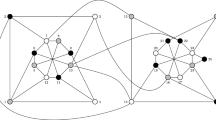Abstract
This paper considers the interplay between semidefinite programming, matrix rank, and graph coloring. Karger, Motwani, and Sudan [10] give a vector program for which a coloring of the graph can be encoded as a semidefinite matrix of low rank. By complementary slackness conditions of semidefinite programming, if an optimal dual solution has sufficiently high rank, any optimal primal solution must have low rank. We attempt to characterize graphs for which we can show that the corresponding dual optimal solution must have sufficiently high rank. In the case of the original Karger, Motwani, and Sudan vector program, we show that any graph which is a k-tree has sufficiently high dual rank, and we can extract the coloring from the corresponding low-rank primal solution. We can also show that if the graph is not uniquely colorable, then no sufficiently high rank dual optimal solution can exist. This allows us to completely characterize the planar graphs for which dual optimal solutions have sufficiently high dual rank, since it is known that the uniquely colorable planar graphs are precisely the planar 3-trees.
We then modify the semidefinite program to have an objective function with costs, and explore when we can create a cost function whose optimal dual solution has sufficiently high rank. We show that it is always possible to construct such a cost function given the graph coloring. The construction of the cost function gives rise to a heuristic for graph coloring which we show works well in the case of planar graphs; we enumerated all maximal planar graphs with a \(K_4\) of up to 14 vertices, and the heuristics successfully colored 99.75% of them.
Our research was motivated by the Colin de Verdière graph invariant [5] (and a corresponding conjecture of Colin de Verdière), in which matrices that have some similarities to the dual feasible matrices must have high rank in the case that graphs are of a certain type; for instance, planar graphs have rank that would imply the 4-colorability of the primal solution. We explore the connection between the conjecture and the rank of the dual solutions.
Supported by NSF grant CCF-2007009.
Access this chapter
Tax calculation will be finalised at checkout
Purchases are for personal use only
Similar content being viewed by others
References
Alizadeh, F.: Interior point methods in semidefinite programming with applications to combinatorial optimization. SIAM J. Optim. 5, 13–51 (1995)
Appel, K., Haken, W.: Every planar map is four colorable. Part I: discharging. Ill. J. Math. 21, 429–490 (1977)
Appel, K., Haken, W., Koch, J.: Every planar map is four colorable. Part II: reducibility. Ill. J. Math. 21, 491–567 (1977)
Brinkmann, G., McKay, B.D.: Fast generation of planar graphs. Math.- Commun. Math. Comput. Chem. 58, 323–357 (2007)
de Verdiére, Y.C.: Sur un nouvel invariant des graphes et un critére de planarité. J. Comb. Theory Ser. B 50, 11–21 (1990)
Fowler, T.G.: Unique coloring of planar graphs. Ph.D. thesis, Georgia Institute of Technology, Department of Mathematics (1998)
Fritsch, R., Fritsch, G.: The Four-Color Theorem. Springer, Berlin, Germany (1994)
Hillar, C.J., Windfeldt, T.: Algebraic characterization of uniquely vertex colorable graphs. J. Comb. Theory Ser. B 98, 400–414 (2008)
Jensen, T.R., Toft, B.: Graph Coloring Problems. John Wiley and Sons, New York, NY, USA (1995)
Karger, D., Motwani, R., Sudan, M.: Approximate graph coloring by semidefinite programming. J. ACM 45(2), 246–265 (Mar 1998). https://doi.org/10.1145/274787.274791
Knuth, D.E.: The sandwich theorem. Electron. J. Comb. 1 (1994). https://www.emis.de/journals/EJC/Volume_1/PDFFiles/v1i1a1.pdf
Lovász, L.: On the Shannon capacity of a graph. IEEE Trans. Inf. Theory IT–25, 1–7 (1979)
Molloy, M., Reed, B.: Graph Colouring and the Probabilistic Method. No. 23 in Algorithms and Combinatorics. Springer, Berlin, Germany (2002)
Ore, O.: The Four-Color Theorem. Academic Press, New York, NY, USA (1967)
Robertson, N., Sanders, D., Seymour, P., Thomas, R.: The four-colour theorem. J. Comb. Theory Ser. B 70, 2–44 (1997)
van der Holst, H., Lovász, L., Schrijver, A.: The Colin de Verdière graph parameter. Graph Theory Comb. Biol. 7, 29–85 (1999)
Wilson, R.A.: Graphs, Colourings, and the Four-Colour Theorem. Oxford University Press, New York, NY, USA (2002)
Author information
Authors and Affiliations
Corresponding author
Editor information
Editors and Affiliations
Rights and permissions
Copyright information
© 2022 Springer Nature Switzerland AG
About this paper
Cite this paper
Mirka, R., Smedira, D., Williamson, D.P. (2022). Graph Coloring and Semidefinite Rank. In: Aardal, K., Sanità, L. (eds) Integer Programming and Combinatorial Optimization. IPCO 2022. Lecture Notes in Computer Science, vol 13265. Springer, Cham. https://doi.org/10.1007/978-3-031-06901-7_29
Download citation
DOI: https://doi.org/10.1007/978-3-031-06901-7_29
Published:
Publisher Name: Springer, Cham
Print ISBN: 978-3-031-06900-0
Online ISBN: 978-3-031-06901-7
eBook Packages: Computer ScienceComputer Science (R0)




